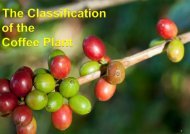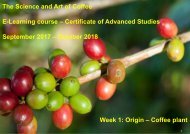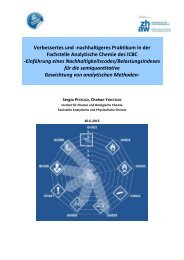You also want an ePaper? Increase the reach of your titles
YUMPU automatically turns print PDFs into web optimized ePapers that Google loves.
Caturra: A pure-line dwarf mutant <strong>of</strong> red Bourbon that has short internodes, which leads to shorter<br />
branches and a compact growth. This natural mutant was discovered in Brazil and first mentioned by <strong>the</strong><br />
Instituto Agronomica de Campinas in 1937. It is highly productive, but with lower vigor and moderate cup<br />
quality and with fast ripening fruits. Its leaf and fruit characteristics are similar to Bourbon, and Caturra<br />
berries can be ei<strong>the</strong>r red or yellow (Yellow Caturra and Red Caturra).<br />
And like Bourbon, it is known to be susceptible to all main diseases and pests. It was never grown in<br />
lowland <strong>plant</strong>ations in Brazil due to its lack in vigour and its suceptibility to c<strong>of</strong>fee diseases, but it has<br />
spread in Colombia and Central America, where it was and still is grown at higher latitudes.<br />
Mundo novo: This tall cultivar was selected from a natural cross <strong>of</strong> Sumatra (Typica) and Red Bourbon in<br />
Brazil (municipality <strong>of</strong> Novo Mundo, today called Urupês, in Sao Paulo state) in <strong>the</strong> 1940s by <strong>the</strong> lnstituto<br />
Agronomica de Campinas (IAC). The variety has been distributed to farmers in Brazil since 1952 replacing<br />
Typica and still forms a basis <strong>of</strong> c<strong>of</strong>fee production in Brazil (35 %). It is characterized by tall height, red fruit,<br />
average maturation time and good vegetative vigor combined with high productivity. Leaf and fruit<br />
characteristics are intermediate between Typica and Bourbon and leaf tips can be green or bronze.<br />
lt has an average cup quality and is susceptible to main pests and diseases. However, with intensive care<br />
in well managed <strong>plant</strong>ations, productivity remains high for Mundo Novo as it is well adapted to <strong>the</strong> Brazilian<br />
climate<br />
41








